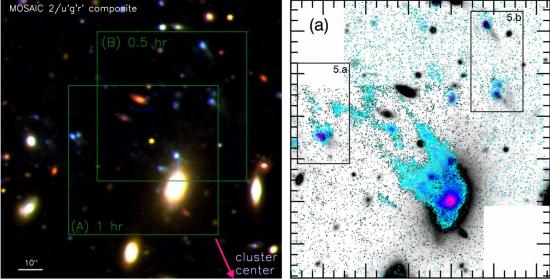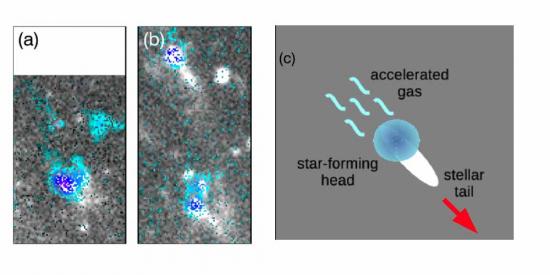An international team including a researcher from the AIM Laboratory-Astrophysics Department of CEA-Irfu has just discovered an elliptical galaxy of completely unexpected shape within the galaxy cluster Abell 2670. Deep observations made by the new MUSE multi-spectrograph recently put into operation at the European Observatory VLT in Chile revealed a highly deformed elliptical galaxy, showing in particular long gas tails and star formation regions normally absent in this type of galaxy. Astronomers now assume that this galaxy has undergone a recent fusion with another gas-rich galaxy. Much of this gas was then driven to the center of the elliptical galaxy during the collision. These results are published in the Astrophysical Journal Letters of May 2017
The shape of galaxies indicates their history
In the Universe, and particularly within clusters of galaxies that group together a large number of galaxies, the shape of galaxies is often disturbed or reshaped due to their movement and eventual collisions. When galaxies are new like ours, they still contain a lot of gas and they can be strongly deformed by the gas pressure as they fall towards the center of the cluster. These deformations then lead to the growth of long gas tails composed of gas and young stars. Their new appearance with these long tentacles made them called "jellyfish galaxies".
On the other hand, in the case of elliptical galaxies, these are older and have long since already used or eliminated the majority of their gas, and consequently form very few new stars and show no gas tails. Until now, none of these elliptical galaxies had ever been observed with an aspect of "jellyfish galaxies".
The surprise came from the deep observation of one of the galaxies of the cluster Abell 2670 thanks to the new multi-spectrograph MUSE. The image revealed a number of astonishing features, such as the presence of ionized gas tails over a length of more than 200 light years and several elongated star formation regions with stellar tails pointing in the direction of movement of the galaxy (which falls towards the center of the cluster) while streams of ionized gas point in the opposite direction.

Left: Fields of view of the MUSE instrument (1'x1 'for each square) superimposed here on a pseudo-color image of the elliptic galaxy of the Abell 2670 cluster. The direction of the cluster center is indicated by the red arrow at the bottom right.
Right: The MUSE observations of this elliptic galaxy in Abell 2670 reveal long ionized gas tails emanating from the disk (visible in the center) as well as star formation regions (visible in zones 5a and 5b).
An enigmatic collision?
All these characteristics are signs that this galaxy was destructured by the pressure of the gas during its fall towards the center of the cluster. The star-forming regions, for example, exhibit a classic ram-pressure-stripping behavior.
When a galaxy falls in the center of the cluster, it passes through the ionized gas of the cluster, which acts like the breath of a wind. It tends to push back the gas of the galaxy which lies downwind, while the stars (which do not respond as easily to the force of the wind) find themselves forward in a stream pointing towards the wind.
The origin of the gas of the galaxy remains however an enigma. Elliptic galaxies normally have much less gas. The researchers have been led to suppose that this galaxy has recently undergone a fusion with an other galaxy rich in gas. Much of this gas was then driven to the center of the elliptical galaxy in the fusion, and is now responsible for a significant rate of star formation observed in the center of the galaxy. Additional investigation into the amount of gas contained and the star formation rate of the galaxy is still needed to draw stronger conclusions about this unusual galaxy. For now, it still remains an intriguing puzzle!
Contact : Pierre-Alain DUC
Publication :
« Discovery of Ram-pressure Stripped Gas around an Elliptical Galaxy in Abell 2670 »
by Yun-Kyeong Sheen et al., published in The Astrophysical Journal Letters, 840:L7 (5pp), 2017 May 1
for an electronic version : Sheen_2017_ApJL_840_L7.pdf
Sheen_2017_ApJL_840_L7.pdf
See : the AAS (American Astronomical Society) press release (May 2017)
See also : - Une vision fine des cirrus galactiques (12 juillet 2016- in French)
- Naissance turbulente des étoiles dans le choc des galaxies (12 mai 2014- in French)
Content : J.M. Bonnet-Bidaud
• Structure and evolution of the Universe › Evolution of the large structures and galaxies





